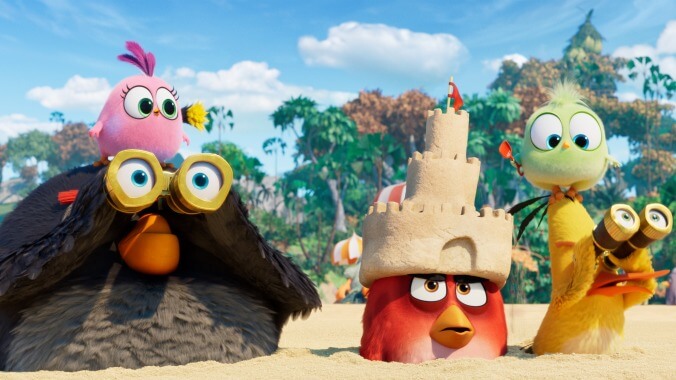The Angry Birds Movie 2 is hardly art, but at least it’s better than its predecessor


Some films are made to last, and some just aren’t. A telltale sign of the latter is an overabundance of topical jokes that go stale faster than the bags of popcorn being munched upon in the theater. This plague is particularly endemic in movies whose target demographic tops out in junior high. A sequel to a movie based on a mobile game whose popularity has been on the decline over the past couple of years, The Angry Birds Movie 2 is the very definition of empty-calorie cinema—bright and shiny and satisfying enough for a few fleeting moments until it’s balled up and thrown in the trash. It’s also fast-paced, interesting to look at, and notably less irritating than the original, which is all you can really ask of a film like this one.
Jason Sudeikis—a solid contender for the title of America’s Dad once Tom Hanks abdicates his throne—returns in the starring role as Red, the bird who saved all the other birds at the end of the first movie. Red’s puffed-up hero persona is a bandage on his lifelong fear of rejection, a neurosis that also makes it impossible for him to work with others without steamrolling his way into a leadership position. He eventually has to learn to put his ego aside and let other people (birds, pigs, whatever) have their turn in the spotlight, a more mature lesson than the “be yourself!” theme that runs through most kids’ movies. That said, there’s also an awkwardly shoehorned-in subplot that seems to exist mostly so Nicole Kidman’s, Viola Davis’, and Gal Gadot’s kids could have voice roles in the film. Mister Rogers’ Neighborhood this is not.
Red learns about cooperation through a new character, Silver (Rachel Bloom), the kid sister of Red’s bleating goofball sidekick, Chuck (Josh Gad). Silver is an engineering genius—once again, kudos to whoever gave that “girls in STEM” presentation at all the Hollywood studios a couple years back—which gives the three-person screenwriting team an opportunity to incorporate trajectories and polymers into the story in a way that’s slightly more organic than “uh, there are ice balls with lava in them in the game?” Speaking of, those ice balls are being flung at birds and pigs by a villainous purple parrot named Zeta (Leslie Jones) from her volcanic lair on Eagle Island, forcing Red to work with both friends and enemies alike in order to save their homelands. Among the new faces in the gang’s subsequent, James Bond-esque adventure are Tiffany Haddish, perfectly paired with Jones as Zeta’s daughter, Debbie; Awkwafina as a pig named Courtney who rarely takes off her headphones; Sterling K. Brown as a Q-type gadget maker named Garry; and Eugenio Derbez, mixing in the occasional Spanglish phrase as another super-genius, this one an eagle named Glenn.
The occasional, surprisingly technical conversation about engineering aside, this isn’t a movie with big ideas on its mind. Watching it, it’s hard not to occupy your own mind with questions like why have all the animals been granted romances, as well as names befitting Midwestern insurance agents? You could also while away the 96 minutes trying to match the cartoon voices with celebrity faces, or admiring the photorealistic texture of the CGI sand (appropriately granular) and CGI feathers (appropriately fluffy). It’s difficult to say whether the actual substance of the film will appeal to kids; at The A.V. Club’s screening, it was the parents who laughed the loudest, seemingly unfazed by having to hear “Baby Shark” again, this time coming from a green cartoon pig.
Director Thurop Van Orman, an Adventure Time writer and creator of the Nickelodeon series The Marvelous Misadventures Of Flapjack, doesn’t completely eschew the more annoying trends of contemporary kids’ movies. But he does moderate them better than his predecessor. There are only two slow-motion sequences set to pop hits in this film compared to four in the first one, for example, and a dumb running joke of cute things uttering euphemistic swears is balanced by a genuinely amusing one poking fun at the cult of self-care. (Zeta says that she “deserves” to take over tropical paradises like Bird Island, because she’s worked hard and needs some “me” time.) Overall, the humor is goofy and lightly meta, paired with colorful, manic visuals that volley across the screen like pinballs in a giant cabinet. Shuffle the family out of the theater before the obligatory cutesy pop theme gets stuck in your head, and it’ll all be forgotten by the end of the car ride home.